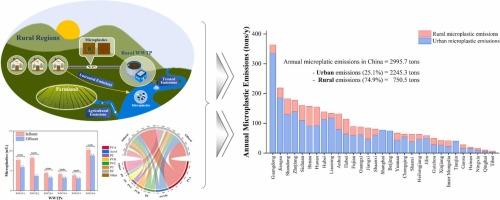Significant effects of Rural Wastewater Treatment Plants in Reducing Microplastic Pollution: A Perspective from China's Southwest Area
IF 12.2
1区 环境科学与生态学
Q1 ENGINEERING, ENVIRONMENTAL
引用次数: 0
Abstract
Sewage systems are a major source for microplastics in riverine exports to oceans. Urban areas are generally considered hotspots for microplastic discharge, whereas emissions from rural areas remain largely understudied. Hence, this study investigated the abundance, characteristics, and polymer types of microplastics in rural wastewater treatment plants (WWTPs) in Guiyang and estimated the annual microplastic emissions of China based on sewage discharge. The influent abundance of microplastics was 3.8-8.2 items/L, the effluent abundance was 3.1-5.9 items/L, with a lower removal rate of 14.4%-54.6%, which might be influenced by lower operating loads and influent concentrations. Raman spectroscopy analysis revealed that polyvinyl alcohol (PVA) was the predominant polymer type. Rural WWTPs were more effective at removing large-sized particles (> 0.1 mm) and films, resulting in higher removal effectiveness by weight (49.1%) compared to urban WWTPs (30.8%). Based on the abundance of microplastics in WWTPs within the study area and China's annual sewage discharge, this study estimated the microplastic emissions released through sewage in China in 2022. The annual microplastic emissions through sewage in China were estimated to be 2995.7 tons, with rural and urban areas contributing 25.1% and 74.9%, respectively. Approximately 724.8 tons and 1001.6 tons of microplastics were removed from rural and urban WWTPs, respectively. This work indicates the unignorable emissions of microplastics from rural sewage and highlights the crucial role of rural WWTPs in reducing microplastic pollution.

农村污水处理厂在减少微塑料污染方面的显著效果:来自中国西南地区的视角
污水系统是河流向海洋排放微塑料的主要来源。城市地区通常被认为是微塑料排放的热点地区,而农村地区的排放在很大程度上仍未得到充分研究。因此,本研究调查了贵阳农村污水处理厂(WWTP)中微塑料的丰度、特征和聚合物类型,并根据污水排放量估算了中国每年的微塑料排放量。微塑料的进水丰度为3.8-8.2个/升,出水丰度为3.1-5.9个/升,去除率较低,为14.4%-54.6%,这可能是受较低的运行负荷和进水浓度的影响。拉曼光谱分析显示,聚乙烯醇(PVA)是主要的聚合物类型。与城市污水处理厂(30.8%)相比,农村污水处理厂在去除大尺寸颗粒(0.1 毫米)和薄膜方面更为有效,因此按重量计,农村污水处理厂的去除率更高(49.1%)。根据研究区域内污水处理厂中微塑料的丰度和中国每年的污水排放量,本研究估算了 2022 年中国污水中微塑料的排放量。中国每年通过污水排放的微塑料估计为 2995.7 吨,其中农村和城市地区分别占 25.1%和 74.9%。农村和城市污水处理厂分别清除了约 724.8 吨和 1001.6 吨微塑料。这项研究表明,农村污水中的微塑料排放量不可忽视,并强调了农村污水处理厂在减少微塑料污染方面的关键作用。
本文章由计算机程序翻译,如有差异,请以英文原文为准。
求助全文
约1分钟内获得全文
求助全文
来源期刊

Journal of Hazardous Materials
工程技术-工程:环境
CiteScore
25.40
自引率
5.90%
发文量
3059
审稿时长
58 days
期刊介绍:
The Journal of Hazardous Materials serves as a global platform for promoting cutting-edge research in the field of Environmental Science and Engineering. Our publication features a wide range of articles, including full-length research papers, review articles, and perspectives, with the aim of enhancing our understanding of the dangers and risks associated with various materials concerning public health and the environment. It is important to note that the term "environmental contaminants" refers specifically to substances that pose hazardous effects through contamination, while excluding those that do not have such impacts on the environment or human health. Moreover, we emphasize the distinction between wastes and hazardous materials in order to provide further clarity on the scope of the journal. We have a keen interest in exploring specific compounds and microbial agents that have adverse effects on the environment.
 求助内容:
求助内容: 应助结果提醒方式:
应助结果提醒方式:


